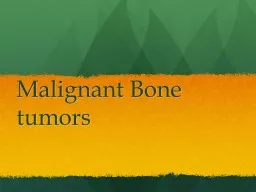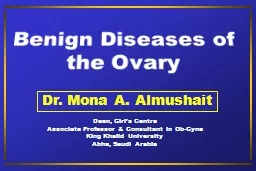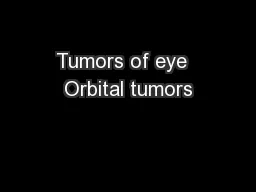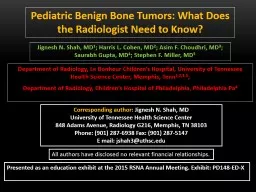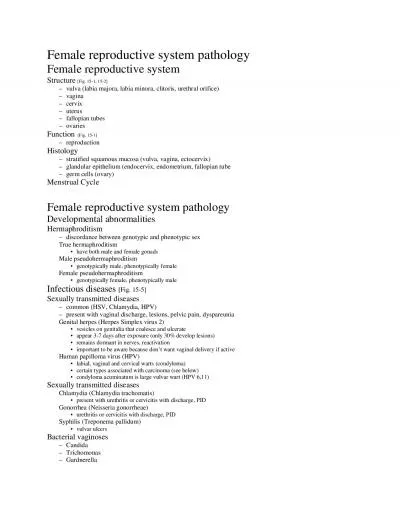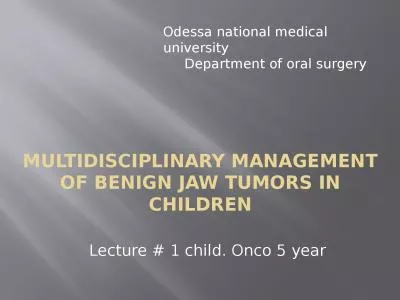PPT-Malignant Bone tumors Malignant vs. Benign Tumors
Author : myesha-ticknor | Published Date : 2018-03-13
Rapid growth warmth tenderness and ill defined edges are suggestive of malignancy Classification of malignant tumors of bone Osteosarcoma Osteogenic sarcoma Chondrosarcoma
Presentation Embed Code
Download Presentation
Download Presentation The PPT/PDF document "Malignant Bone tumors Malignant vs. Ben..." is the property of its rightful owner. Permission is granted to download and print the materials on this website for personal, non-commercial use only, and to display it on your personal computer provided you do not modify the materials and that you retain all copyright notices contained in the materials. By downloading content from our website, you accept the terms of this agreement.
Malignant Bone tumors Malignant vs. Benign Tumors: Transcript
Rapid growth warmth tenderness and ill defined edges are suggestive of malignancy Classification of malignant tumors of bone Osteosarcoma Osteogenic sarcoma Chondrosarcoma Ewings sarcoma. Malignant tumors can be classified as primary tumors or metastatic tumors Metastatic tumors can arise from a variety of primary malignant tumors The term Sister Josephs nodule is used to describe a malignant umbilical tumor The tumor is usually asso Dr. Mona A. Almushait. Dean, Girl’s Centre. Associate Professor & Consultant in Ob-. Gyne. King Khalid University . Abha. , Saudi Arabia. The Ovary. The human ovary has a striking propensity to develop a wide variety of tumors, most of which are benign.. Questions. What are the treatments for cyclical . mastalgia. ?. What is the . DDx. of nipple discharge? How should this be managed?. What are . phylloides. . tumours. of the breast and how are they managed?. - Ovarian cancer accounts for 3% of all cancers in females. About 80% . of ovarian tumors are . benign, and these occur mostly in young women between the ages of 20 and 45 years and may be entirely asymptomatic and occasionally are found unexpectedly on abdominal or pelvic examination . DR HEYAM AWAD. FOLLICULAR AND LUTEAL CYSTS.. POLYCYSTIC OVARY.. OVARIAN TUMORS.. FOLLICULAR AND LUTEAL CYSTS. COMMON.. CONSIDERED VARIANTS OF NORMAL PHYSIOLOGY.. ORIGENATE FROM UNRUPTURED FOLLICLES.. Neoplasm (neo=. new,plasm. =growth). Tumors may be defined as swelling or as a neoplasm. Remember Not all neoplasms form tumors.. Ex: Leukemia (. Leuk. =white, . emia. =blood) is a malignant disease of the bone marrow that causes an increase in white blood cells and might not form distinctive tumors.. Begin . Dermoid. cyst. Mucocele. Hemangioma. Lymphangioma. Malignant . rabdomyosarcoma. Benign tumors of the orbit . can develop from infancy and grow rapidly or slowly. It can be superficial and easily identifiable by external presentation, palpation and x – rays or CT scan . Jignesh. N. Shah, MD. 1. ; . Harris L. Cohen, . MD. 2. ; . Asim. F. Choudhri, . MD. 3. ; Saurabh Gupta, MD. 4. ; Stephen F. Miller, . MD. 5. Department of Radiology, Le Bonheur Children’s Hospital, University of Tennessee Health Science Center, Memphis, . . in children. Odessa national medical university. Department of oral surgery . Lecture # 2 child. . o. nco. . for 5 year. Odontogenic. epithelium with mature, fibrous . stroma. without . odontogenic. Jreisat. Approach. History. -Age:. most primary lesions appear in childhood and . adolescence . while lesions in elderly are usually metastatic. -Pain:. indicates nature and site of tumor. -Swelling:. JOURNAL OFRESEARCH AND PRACTICEON THE MUSCLOSKELETAL SYSTEM Journal of Research and Practice , Georgia Antoniou, Ioannis K. Triantafyllopoulos“Agia Sofia” General Children’s Hospital, D Intr Patients and methods Between 1975 and 2002, a total of 46 patients with giant cell bone J Orthopaed Traumatol (2003) 3:126DOI 10.1007/s10195-003-0024-3 M. ValeoR. Trinchi Received: 19 May 2003Acc Female reproductive system pathology Infections Pelvic inflammatory disease chronic, extensive infection of upper reproductive tract usually secondary to STD (Neisseria, Chlamydia) salpingitis, tubo-o Children. Lecture # 1 child. . Onco. 5 year. Odessa national medical university. Department of oral surgery . A tumor is defined, in brief, as abnormal growth of tissue; . tumoral. formations are classified.
Download Document
Here is the link to download the presentation.
"Malignant Bone tumors Malignant vs. Benign Tumors"The content belongs to its owner. You may download and print it for personal use, without modification, and keep all copyright notices. By downloading, you agree to these terms.
Related Documents

